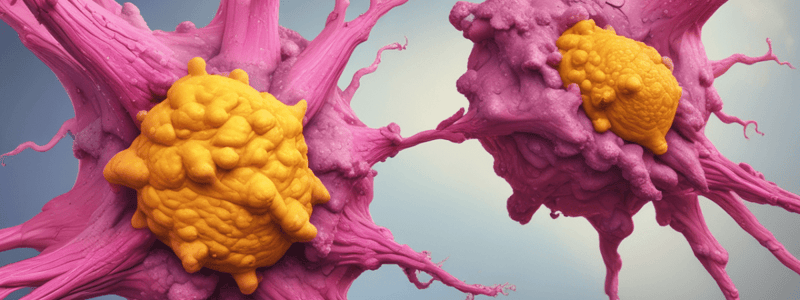Podcast
Questions and Answers
Which type of peripheral nerve sheath tumor is most commonly associated with neurofibromatosis type 1 (NF1)?
Which type of peripheral nerve sheath tumor is most commonly associated with neurofibromatosis type 1 (NF1)?
- Malignant peripheral nerve sheath tumor
- Plexiform neurofibroma (correct)
- Schwannoma
- Localized cutaneous neurofibroma
What is the key microscopic feature that distinguishes schwannomas from neurofibromas?
What is the key microscopic feature that distinguishes schwannomas from neurofibromas?
- The presence of a dense cellular area (Antoni A) and a loose hypocellular area (Antoni B)
- The presence of nuclear palisading and Verocay bodies (correct)
- The presence of axons within the tumor
- The presence of a well-defined capsule around the tumor
Which of the following statements about the anatomical origin of peripheral nerve sheath tumors is correct?
Which of the following statements about the anatomical origin of peripheral nerve sheath tumors is correct?
- Malignant peripheral nerve sheath tumors can arise from pre-existing benign peripheral nerve sheath tumors (correct)
- Neurofibromas always arise from the endoneurium of a nerve
- All peripheral nerve sheath tumors originate from the nerve root
- Schwannomas always arise from the perineurium of a nerve
What is the most common cranial nerve affected by schwannomas?
What is the most common cranial nerve affected by schwannomas?
Which of the following is the most characteristic microscopic feature of plexiform neurofibromas?
Which of the following is the most characteristic microscopic feature of plexiform neurofibromas?
Which of the following peripheral nerve sheath tumors is most likely to be associated with symptoms related to nerve root compression?
Which of the following peripheral nerve sheath tumors is most likely to be associated with symptoms related to nerve root compression?
What is the characteristic cytologic feature of Undifferentiated Sarcoma Pleomorphic Fibroblastic Sarcoma/Pleomorphic Undifferentiated Sarcoma?
What is the characteristic cytologic feature of Undifferentiated Sarcoma Pleomorphic Fibroblastic Sarcoma/Pleomorphic Undifferentiated Sarcoma?
Which of the following is true about the chromosomal profile of Undifferentiated Sarcoma Pleomorphic Fibroblastic Sarcoma/Pleomorphic Undifferentiated Sarcoma?
Which of the following is true about the chromosomal profile of Undifferentiated Sarcoma Pleomorphic Fibroblastic Sarcoma/Pleomorphic Undifferentiated Sarcoma?
Where are Synovial Sarcomas typically located?
Where are Synovial Sarcomas typically located?
Which of the following is a characteristic feature of Synovial Sarcoma?
Which of the following is a characteristic feature of Synovial Sarcoma?
What is the typical age range for the presentation of Synovial Sarcoma?
What is the typical age range for the presentation of Synovial Sarcoma?
What is the typical size range of Undifferentiated Sarcoma Pleomorphic Fibroblastic Sarcoma/Pleomorphic Undifferentiated Sarcoma?
What is the typical size range of Undifferentiated Sarcoma Pleomorphic Fibroblastic Sarcoma/Pleomorphic Undifferentiated Sarcoma?
Which type of nerve sheath tumor is associated with a small but real risk of malignant transformation?
Which type of nerve sheath tumor is associated with a small but real risk of malignant transformation?
What is a unique characteristic of neurofibromas compared to schwannomas?
What is a unique characteristic of neurofibromas compared to schwannomas?
Which nerve sheath tumor may appear circumscribed?
Which nerve sheath tumor may appear circumscribed?
What is the unique feature of diffuse neurofibromas in terms of growth pattern within the skin?
What is the unique feature of diffuse neurofibromas in terms of growth pattern within the skin?
Which type of nerve sheath tumor involves multiple fascicles of individual affected nerves?
Which type of nerve sheath tumor involves multiple fascicles of individual affected nerves?
What is the genetic basis of Neurofibromatosis-1 (NF1)?
What is the genetic basis of Neurofibromatosis-1 (NF1)?
Which of the following is NOT a common metastatic site for cancers?
Which of the following is NOT a common metastatic site for cancers?
What is the typical 5-year survival rate for cancers that have metastasized?
What is the typical 5-year survival rate for cancers that have metastasized?
Which of the following is NOT a tumor-like lesion described in the text?
Which of the following is NOT a tumor-like lesion described in the text?
What is the typical size of a ganglion cyst?
What is the typical size of a ganglion cyst?
Where are Tenosynovial Giant Cell Tumors most commonly found?
Where are Tenosynovial Giant Cell Tumors most commonly found?
What is the typical age range for patients with Tenosynovial Giant Cell Tumor?
What is the typical age range for patients with Tenosynovial Giant Cell Tumor?
Which statement about rhabdomyosarcoma is correct?
Which statement about rhabdomyosarcoma is correct?
Which of the following is true about sarcoma botryoides?
Which of the following is true about sarcoma botryoides?
Which of the following statements about leiomyomas is incorrect?
Which of the following statements about leiomyomas is incorrect?
Which of the following is a diagnostic feature of rhabdomyosarcoma?
Which of the following is a diagnostic feature of rhabdomyosarcoma?
Which of the following statements about leiomyosarcomas is correct?
Which of the following statements about leiomyosarcomas is correct?
Which of the following immunohistochemical markers is useful in confirming the smooth muscle origin of a tumor?
Which of the following immunohistochemical markers is useful in confirming the smooth muscle origin of a tumor?




